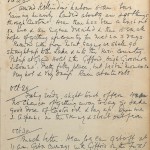The conservation of special collections materials is rarely a straightforward endeavor. It’s important to treat each item as a unique object, and to let its particular history and condition drive the decision-making process. Often, the path forward is only revealed once treatment begins, as the conservator becomes more and more familiar with the book, sometimes through research and analysis, but often simply by observing and handling the book over a period of time.


